“The only thing we learn from history is that we learn nothing from history.” – Friedrich Hegel. History has given us a wealth of must-watch sites to explore and appreciate. These places show the deep history of human culture, highlighting the most important sites to see. From the grand Pyramids of Giza to the impressive Great Wall of China, each site tells a story of past civilizations.
As you travel through these historical spots, you’ll see some of the most famous attractions. They offer a glimpse into the triumphs and challenges that have shaped our world.
- Explore iconic locations that showcase human achievement.
- Gain insights into the cultural significance of historical landmarks.
- Experience the journey through our rich global heritage.
- Discover the stories behind each must-watch historical site.
- Engage with the past through remarkable visiting experiences.
- Learn about the construction and significance of ancient structures.
The Great Wall of China
The Great Wall of China is a marvel of ancient engineering. It stretches over 21,000 kilometers, crossing 15 provinces and 404 counties. It’s a top historical site in the world2. This ancient wonder has protected China’s land and culture for centuries.
Historical Significance
The Great Wall took nearly 2,000 years to build, starting in the 3rd century BC and ending in the 17th century AD3. It was a strong defense against invaders. Today, it’s a UNESCO World Heritage site, showing China’s strength and history.
Visitor Tips
When you visit, check out the top 10 sections around Beijing’s north and east4. Mutianyu is great for its beauty, while Jinshanling is both charming and challenging. Jiankou is steep, and Simatai is famous for night tours.
Spring or autumn is the best time to visit. Spend at least half a day to see its beauty and take amazing photos4.
The Colosseum
The Colosseum is a symbol of Rome’s grandeur. It’s known for its ancient Roman architecture. This amazing structure hosted famous gladiatorial contests and public events, drawing visitors worldwide. It’s one of the top historical attractions, with immense historical value.
Gladiatorial Contests and Public Events
Built between 70-80 AD, the Colosseum is Rome’s largest amphitheater5. It was made for events like deadly gladiatorial fights, entertaining the crowds. It could hold 50,000 to 80,000 people, showing its massive size.
Imagine the crowd’s roar as gladiators battled for their lives. When you visit, go in spring (April to June) or fall (September to October). These months have better weather and fewer tourists5.
Plan for a 2-3 hour tour to see its architecture and history. Guided tours offer deep insights, making your visit better.
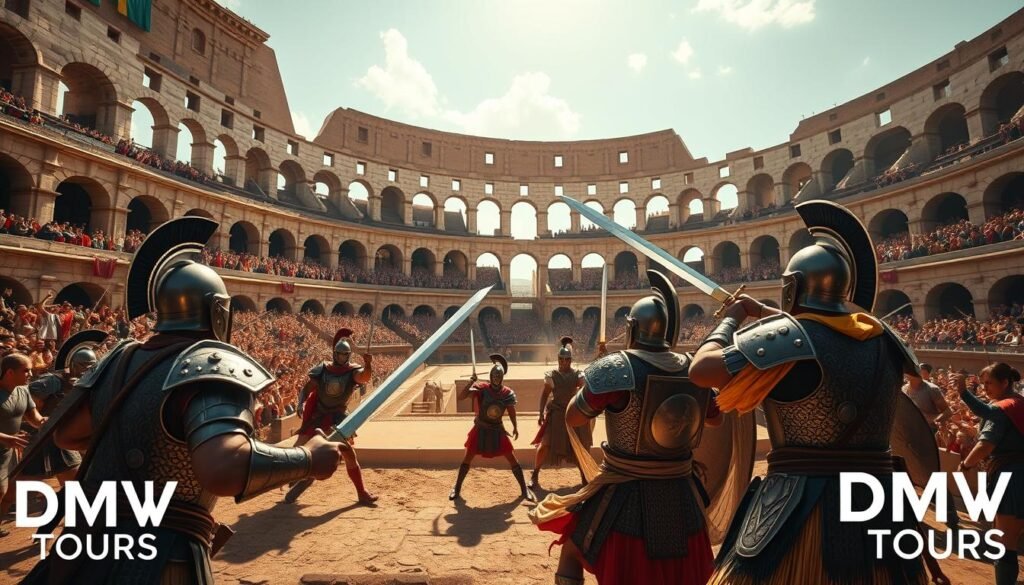
Buy tickets early, especially in busy seasons5. It saves time and lets you see this top historical site. The Colosseum is a must-see for history buffs and casual visitors.
Machu Picchu
Machu Picchu is a famous historical site in Peru’s Andes. It’s a UNESCO World Heritage Site, known for its cultural and ecological value. At 2,430 meters high, it shows the Inca’s amazing building skills and stunning views6.
Visiting Machu Picchu means seeing its amazing buildings and secrets.
UNESCO World Heritage Status
Machu Picchu is a UNESCO World Heritage Site. It shows the Inca’s engineering and knowledge of the stars. It has about 200 buildings, used for religion, ceremonies, and farming6.
The site covers 32,592 hectares, showing its unique plants and animals6. The stones in the Temple of the Sun and the Temple of the Condor show the Inca masons’ skill7.
Visiting Recommendations
Best time to visit Machu Picchu is May to October. Spend at least a day to see it all6. Don’t miss Intihuatana and Inti Punku for their views and myths7.
Intimachay, the Cave of the Sun, is also worth seeing. Its wall shines bright during the Summer Solstice7.
If you have time, try the Salkantay Trek to Machu Picchu. It offers beautiful views and challenges. Visiting Machu Picchu is a memorable experience, blending history, culture, and nature8.
Pyramids of Giza
The Pyramids of Giza are a stunning example of ancient Egypt’s creativity and deep culture. Built over 5,000 years ago, they are a key part of our shared history. The Great Pyramid of Giza, built around 2570 BC, is the only Ancient Wonder still mostly standing9. It was the world’s tallest building for 3,800 years until 1311 AD9.

Cultural Significance in Ancient Egypt
The Giza Plateau is more than just pyramids. It includes nine pyramids, the Great Sphinx, and smaller tombs9. The Great Pyramid of Khufu was once 482 feet tall with sides of 755 feet10. Its design shows the ancient Egyptians’ knowledge of astronomy and math, highlighting their advanced civilization.
Best Time to Visit
Choosing the right time to visit the Pyramids of Giza is important. Winter, especially midday and afternoon, is best to avoid haze9. If you’re visiting from March to October, mornings are cooler. Fridays and Saturdays are busier because schools are closed9. Entrance fees differ; it’s 900 EGP for the Great Pyramid, and 280 EGP for the other pyramids9. Taking photos with your phone inside the Great Pyramid is free, making your visit even more special.
| Aspect | Details |
|---|---|
| Height of Great Pyramid | Originally 482 feet (147 m) |
| Construction Era | Around 2570 BC |
| Best Winter Visit Times | Midday to afternoon |
| Entrance Fee for Great Pyramid | 900 EGP |
| Entrance Fee for Other Pyramids | 280 EGP |
The Taj Mahal
The Taj Mahal is a UNESCO World Heritage site. It’s a stunning example of Mughal architecture and one of the world’s most famous landmarks. It was built by Mughal emperor Shah Jahan in memory of his wife, Mumtaz Mahal. This mausoleum is a symbol of love and art.
Built between 1632 and 1648, it’s in Agra, India. Agra has a population of about four million people11.
Mughal Architecture
The Taj Mahal is famous for its marble inlay work and perfect symmetry. It covers nearly 17 hectares. The main dome is surrounded by gardens and four minarets at the corners12.
The craftsmanship is incredible. It uses semi-precious stones to decorate the marble. This shows the highest level of Indo-Islamic architecture12.
Visiting Tips
The best time to visit the Taj Mahal is from October to March. The weather is nice then. Spend at least half a day to fully enjoy it.
Remember to follow the visitor guidelines. Nearby attractions like Agra Fort and places to stay make your trip better. For more tips, check out practical visiting advice.
Ma’an Governorate, Jordan
The Ma’an Governorate is known for its rich history, especially its Nabatean cities. These ancient cities were key trade centers. They show the Nabateans’ amazing building and engineering skills.
Visiting these sites gives us a peek into their lively past. We learn how the Nabateans used innovation and resourcefulness to thrive. Their buildings are not just impressive but also help us understand ancient cultures.
Historical Importance of Nabatean Cities
Petra, in the Ma’an Governorate, is a world-famous site, a UNESCO World Heritage Site since 1985. It was the capital of the Arab Nabataeans, established around 312 BC. The city covers 103 square miles, showcasing incredible rock-cut architecture and water systems.
These cities, like Petra, were built to survive in Southern Jordan’s harsh climate. Their preservation highlights the Nabateans’ ingenuity. This makes Ma’an Governorate crucial for studying history and archaeology1314.
Ma’an is also a key transport hub, connecting places through ancient and modern roads. By 2020, it had about 50,350 people, showing its growing importance15. Visitors can explore the canyon views and carved structures, gaining insight into the Nabateans’ cultural legacy13.

The Acropolis
The Acropolis is a key symbol of ancient Greece. It shows some of the most famous historical places worldwide. This ancient citadel in Athens has impressive structures that have shaped the region’s culture for centuries.
Structures within the Acropolis
The Parthenon is a highlight of the Acropolis. It was dedicated to Athena and has seen many changes, from temple to mosque16. The Erechtheion, built between 421 and 405 B.C., honors Athena and other deities17. The Temple of Athena Nike, known for its beauty, was built between 421 and 415 B.C17.
Visiting Guidelines
Visit the Acropolis in spring or autumn for better weather. You’ll need about three hours to explore and enjoy the views18. Following visitor guidelines is important to protect this famous landmark.
- Plan your visit early in the day to avoid crowds.
- Wear comfortable shoes for walking on uneven terrain.
- Don’t forget to stay hydrated during your exploration.
- Respect all signage to help preserve this UNESCO World Heritage site.
| Structure | Year Built | Significance |
|---|---|---|
| Parthenon | 447-432 B.C. | Temple dedicated to Athena, symbolizes ancient Greek culture |
| Erechtheion | 421-405 B.C. | Dedicated to Athena and Poseidon, showcases classical architecture |
| Temple of Athena Nike | 421-415 B.C. | Represents victory and worship of Athena |
| Propylaea | 430s B.C. | Gateway to the Acropolis, an architectural marvel |
The Acropolis is a must-see for anyone interested in ancient Greece16.
Angkor Wat
Angkor Wat is a symbol of Cambodia’s rich culture and spirituality. It’s the largest religious structure in the world, built in the 12th century. Originally dedicated to Vishnu, it combines Hindu and Buddhist styles.
As a key part of the Khmer Empire, it’s a top historical site. Its bas-reliefs and statues tell epic stories. This makes it a must-see for history lovers.
Religious and Cultural Significance
Angkor Wat is deeply connected to Cambodian identity and spirituality. The Angkor Archaeological complex has hundreds of temples. It was once home to a million people.
Angkor Wat covers 494 acres, a source of pride for Cambodians. It draws millions of visitors each year, making it Cambodia’s top tourist spot19. Nearby, the Bayon Temple with its 216 stone faces adds to the area’s cultural richness20.
Visitor Experience
Visiting Angkor Wat is best from November to February for the weather. Spend a full day to fully experience its history and art. Walking through, you’ll see temples like Ta Prohm and Banteay Srei.
Each temple shows the creativity and hard work of the Khmer civilization as historical accounts tell us. Your visit will deepen your understanding of Cambodian culture. It will also leave you with a lasting appreciation for this historical gem.
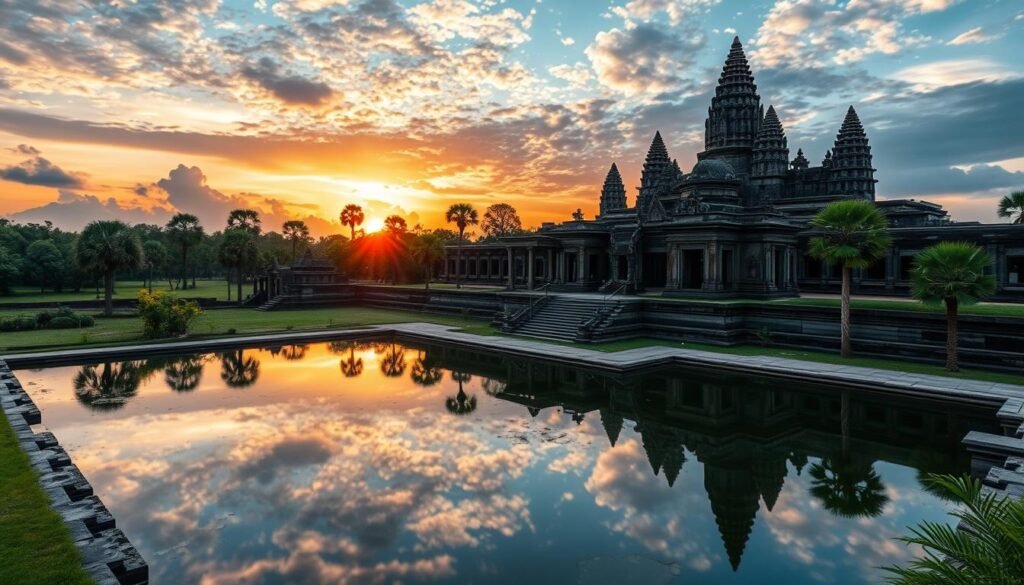
The Alhambra
The Alhambra in Granada, Spain, is a breathtaking example of Islamic architecture. It attracts millions of visitors every year. This site, the most visited in Spain, shows the Nasrid dynasty’s artistry from the 13th and 14th centuries21. It was named the eighth wonder of the world, drawing tourists to its rich history and beauty22.
The Alcazaba is the oldest part, offering stunning views of the city from its towers. Built in the early Middle Ages, the Zirid dynasty’s renovations made it even more beautiful. The Court of the Lions is a highlight, blending Persian and Arabic styles21.
The Palace of Charles V is another must-see, showcasing Renaissance architecture. It houses the Museum of Fine Arts and the Museum of the Alhambra22. Getting there is easy; buses run often from the city center, or you can walk from Plaza Nueva in about half an hour. Because of the crowds, booking tours in advance is a good idea22.
The Forbidden City
The Forbidden City in Beijing is a key symbol of China’s past. It was the center of the Ming and Qing dynasties for over 500 years. This place is not just about its grand buildings but also about China’s rich culture.
Imperial History of China
The Forbidden City covers over 720,000 square meters. It’s China’s largest and most important ancient building complex23. With 980 buildings across 90 neighborhoods, it shows off Ming and Qing styles and influences from Han, Mongolian, and Tibetan cultures24.
It was a UNESCO World Heritage site since 1987, showing its global importance24. For over 500 years, it was off-limits to the public until 192524.
The complex has a 3.4-kilometer wall and a 52-meter wide moat23. The wall is 10 meters high, making the buildings inside look even more impressive23. Every year, 16 million people visit, making it a top attraction25.
Visiting times are busiest during China’s Golden Week in early October. But spring and autumn are cooler and less crowded24.
Inside, you’ll see over 1 million artworks, one-sixth of China’s cultural relics23. Wear comfy shoes to explore the complex, which is also accessible for those with mobility issues24. Don’t miss the Imperial Garden, a beautiful 7,000 square meter area at the complex’s north end25.
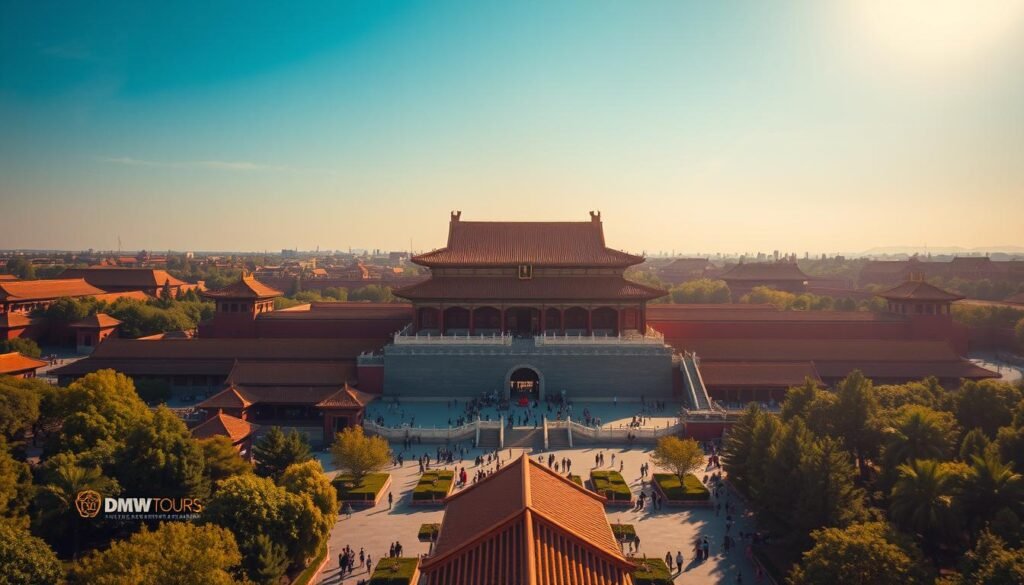
The Palace of Versailles
The Palace of Versailles is a symbol of the 17th century’s grandeur. It’s considered a top historical spot to visit. Originally a hunting lodge built by Louis XIII in 1631, Louis XIV transformed it in 1661. He spent nearly 100 million Livres on its construction26.
This landmark boasts 2,300 rooms, showcasing stunning Baroque architecture. It’s known for its elegant design27.
Baroque Architectural Features
The Palace’s gardens took over 40 years to build. They are maintained every century to keep their beauty27. The Hall of Mirrors is famous for its 357 mirrors and 30 ceiling paintings. It shows the Palace’s opulence28.
Visitors can also see the Grand Trianon and the Petit Trianon. These are part of the 2,000-acre estate28.
Spring and autumn are the best times to see the gardens. You can enjoy paddle boating or art exhibits. These activities make your visit unforgettable28.
To learn more about the Palace’s history and architecture, check out this site. It provides detailed information on guided tours. These tours let you see the Palace’s historical significance up close27.
The Roman Forum
The Roman Forum is a key part of ancient Rome’s history. It shows the city’s politics, religion, and economy. This site has many landmarks that tell the story of Rome.
The Arch of Titus is a standout, being one of the few arches left from 36. It celebrates Roman victories and shows off ancient Roman art29. Built in A.D. 81, it has detailed reliefs that were a big step forward in Roman art29.
The Arch of Septimius Severus, built in 203 A.D., also tells a story of Roman victories. Though damaged, its carvings are still impressive30.
The Temple of Saturn stands out with its eight Egyptian granite columns. It shows the temple’s grandeur and importance30. The Basilica of Maxentius is huge, with massive vaults. It was a key place for public life30.
The Temple of Romulus still has its original bronze doors from A.D. 309. It honors Valerius Romulus, the son of Emperor Maxentius. This temple mixes myth and history29. The House of the Vestal Virgins gives a glimpse into the lives of these important women who kept Rome’s sacred flame30.
Visiting the Roman Forum is best in spring or autumn. It takes about three hours to see everything. You’ll be amazed by the architecture and history of this world-famous site.

Hagia Sophia
The Hagia Sophia is a key symbol of architectural greatness and deep history in Istanbul. Built in 537 by Emperor Justinian, it combines different styles from its past roles. It’s now one of the most famous historical sites globally. Originally a Byzantine church, it became an Ottoman mosque for 482 years, showing its varied history3132.
Architectural Marvels
The Hagia Sophia is known for its huge dome and detailed mosaics. When you visit, you’ll see the VI. Leon Mosaic from the 10th century and the Emperor’s Gate from the 6th century31. Its 361 doors, including 101 large ones, show its grandeur and importance31.
Multifaceted History
The Hagia Sophia’s history is filled with legends and cultural importance. It’s said to have held relics of Jesus and seen the rise and fall of empires. Local stories tell of an apocalyptic inscription and the devil being trapped in a marble during its mosque conversion3132. To truly experience it, visit in spring or autumn and spend at least half a day exploring to uncover its historical treasures.
Tower of London
The Tower of London was built in 1078 by King William the Conqueror. It stands as a symbol of Britain’s complex history. This famous landmark has played many roles over the years.
First, it was a royal palace and fortress. Later, it became a prison and an armory, especially during the Tudor era in the 15th century. It gained notoriety for holding famous prisoners.
Historical Role and Significance
Notable figures like Anne Boleyn and Sir Walter Raleigh were held here. This makes it a significant historical site. The medieval fortress, known as the White Tower, is one of the largest castle keeps in Europe.
The Tower is also known for its role in executions. Ten documented executions took place at Tower Green, including three queens: Anne Boleyn, Catherine Howard, and Lady Jane Grey3334.
Over the centuries, at least 8,000 prisoners were held here. This has made the Tower one of the most haunted castles in England33. Visitors are drawn by its tragic past and its status as a significant historical site.
The Tower’s architecture, including the chapel from the 12th century, shows its rich cultural heritage33.
Visiting the Tower of London usually takes about half a day. Spring or autumn are the best times to see its unique and sometimes eerie atmosphere.
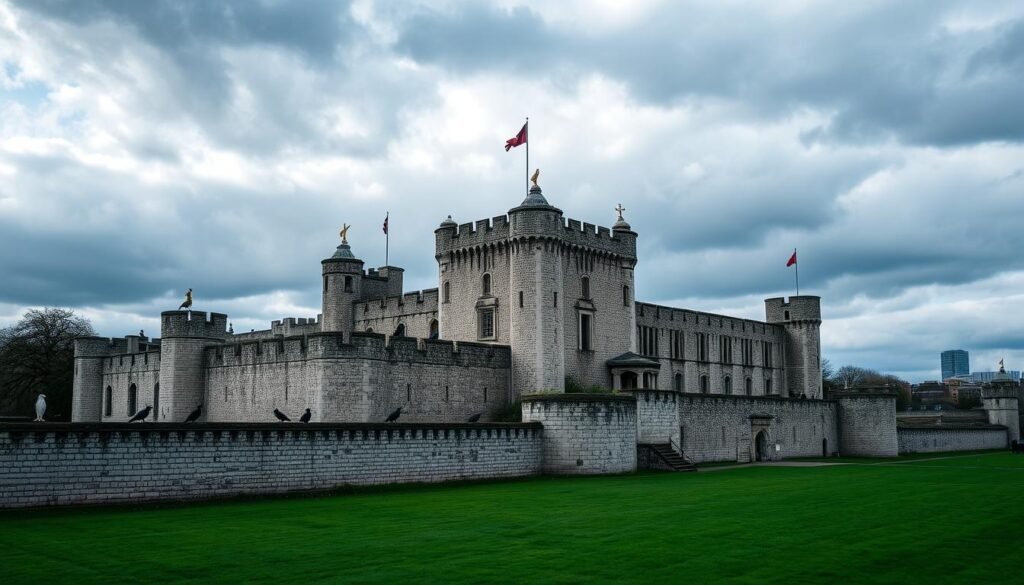
The Pantheon
The Pantheon is a top historic landmark in Rome, showing off ancient Roman engineering skills. It was finished around 125 A.D. during Emperor Hadrian’s rule. It was first built by Marcus Agrippa and then rebuilt after a fire in 80 A.D3536.
The dome is amazing, being the biggest unreinforced concrete dome ever. It’s 142 feet wide and tall, matching its height to its width.
Engineering Feats of the Ancient Romans
This architectural wonder has a stunning oculus, a 30-foot wide opening. It lets natural light flood the inside. Over the years, it has been used as a church since 609 A.D3536.
Today, it’s still a church and a tomb. Famous figures like Renaissance artist Raphael are buried here.
At the entrance, you’ll see Corinthian columns made of granite. Inside, there are detailed sculptures, paintings, and a marble floor. The Pantheon is a key historical site in Rome.
When you visit, remember that masses are held often. You’ll need to dress properly. The area around it is lively, with food places, a fountain, and street performers. It’s a great place to experience Rome’s culture.
Must-Watch Historical Sites
Exploring historical sites helps us understand different histories that shape our culture. These sites show off amazing architecture and tell stories of big events that changed the world. By visiting these places, you learn more about the past and help local economies grow.
A Global Perspective on Historical Tourism
Traveling to historical attractions lets you connect with humanity’s stories. For example, Angkor Wat is the biggest religious building, showing incredible skill and history37. The Alhambra in Spain is a top spot, attracting millions yearly37. Chichen Itza, one of the Seven New Wonders, shows our interest in ancient cultures37.
The Great Wall of China, the longest manmade thing, and the Forbidden City, the biggest palace, are also must-sees. They amaze visitors with their size and history. Visiting these places deepens your understanding of cultures and history, making each trip educational.
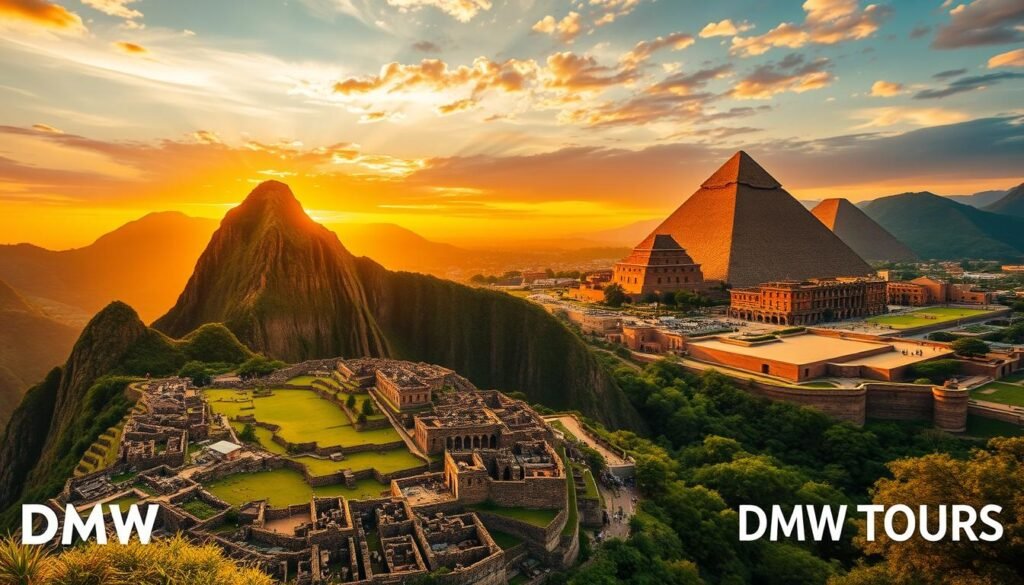
Traveling to these places through historical tourism satisfies your desire to explore. It also lets you see the complex history of humanity. For more tips and insights, check out this resource to plan your next trip to these iconic sites.
| Historical Site | Country | Significance |
|---|---|---|
| Angkor Wat | Cambodia | Largest religious structure |
| The Alhambra | Spain | Most visited historic attraction |
| Chichen Itza | Mexico | One of the Seven New Wonders of the World |
| The Great Wall of China | China | Longest manmade structure |
| Forbidden City | China | Largest imperial palace |
Visiting these sites helps us understand our shared history and keeps these treasures alive for the future. As you plan your trips, think about the unique experiences these landmarks offer. Dive into the rich history that makes them special37.
Conclusion
Exploring must-see historical locations around the world is key to understanding our past. Each place, like the Great Wall of China or the Taj Mahal, has its own story. These stories make your travels richer.
More people are interested in visiting these famous spots. This is thanks to tour companies like LivTours and TourGuy, which focus on history38.
Platforms like TripAdvisor and Viator help you dive into cultural experiences. They make it easy to find unique places to stay, like VRBO. This shows how much people value historical travel38.
Visiting these sites is more than just seeing sights. It’s a way to connect with our shared history. It encourages future generations to explore our rich past.
So, when planning your next trip, remember these historical gems are waiting for you. They’re ready to share their stories and secrets with you38.

Leave a Reply